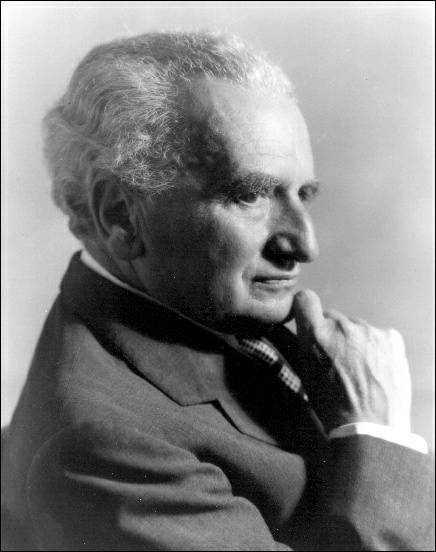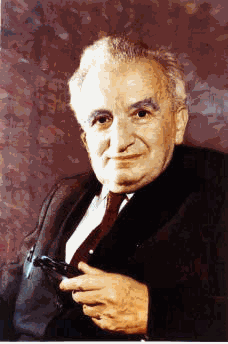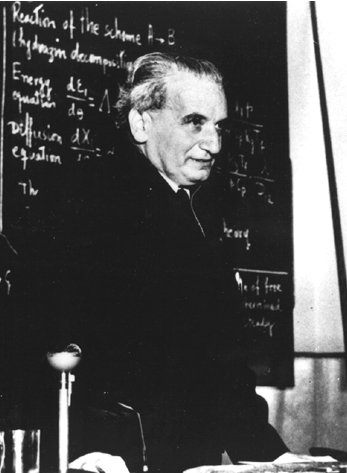<Back to Index>
- Aerospace Engineer Theodore von Kármán, 1881
- Composer Anatoly Konstantinovich Lyadov, 1855
- Emperor of the Byzantine Empire Flavius Petrus Sabbatius Iustinianus Augustus, 483
PAGE SPONSOR



Theodore von Kármán (original Hungarian name: Szőllőskislaki Kármán Tódor) (May 11, 1881 – May 7, 1963) was a Hungarian - American aerospace engineer and physicist who was active primarily in the fields of aeronautics and astronautics. He is responsible for many key advances in aerodynamics, notably his work on supersonic and hypersonic airflow characterization.
Von Kármán was born into a Jewish family at Budapest, Austria - Hungary as Kármán Tódor. One of his ancestors was Rabbi Judah Loew ben Bezalel. He studied engineering at the city's Royal Joseph Technical University, known today as Budapest University of Technology and Economics. After graduating in 1902 he moved to Germany and joined Ludwig Prandtl at the University of Göttingen, and received his doctorate in 1908. He taught at Göttingen for four years. In 1912 accepted a position as director of the Aeronautical Institute at RWTH Aachen, one of the country's leading universities. His time at RWTH Aachen was interrupted by service in the Austro - Hungarian Army 1915 – 1918, where he designed an early helicopter. He is believed to have founded the International Union of Theoretical and Applied Mechanics in September 1922 by organizing its first conference in Innsbruck. He left RWTH Aachen in 1930.
Apprehensive about developments in Europe, in 1930 he accepted the directorship of the Guggenheim Aeronautical Laboratory at the California Institute of Technology (GALCIT) and emigrated to the United States. In 1936, along with Frank Malina and Jack Parsons, he founded a company Aerojet to manufacture JATO rocket motors. He later became a naturalized citizen of the United States.
German activity during World War II increased U.S. military interest in rocket research. During the early part of 1943, the Experimental Engineering Division of the United States Army Air Forces Materiel Command forwarded to von Kármán reports from British intelligence sources describing German rockets capable of reaching more than 100 miles (160 km). In a letter dated 2 August 1943 von Kármán provided the Army with his analysis of and comments on the German program.
In 1944 he and others affiliated with GALCIT founded the Jet Propulsion Laboratory, which is now a Federally funded research and development center managed and operated by Caltech under a contract from NASA. In 1946 he became the first chairman of the Scientific Advisory Group which studied aeronautical technologies for the United States Army Air Forces. He also helped found AGARD, the NATO aerodynamics research oversight group (1951), the International Council of the Aeronautical Sciences (1956), the International Academy of Astronautics (1960), and the Von Karman Institute for Fluid Dynamics in Brussels (1956). In June 1944, von Kármán underwent surgery for intestinal cancer in New York City. The surgery caused two hernias,
and von Kármán's recovery was slow. Early in September,
while still in New York, he met with U.S. Army Air Forces Commanding General Henry H. Arnold on a runway at La Guardia Airport. Hap Arnold then proposed that von Kármán move to Washington, D.C. to lead the Scientific Advisory Group and become a long range planning consultant to the military. He returned to Pasadena around
mid September. Von Kármán was appointed to the position
on October 23, 1944, and left Caltech in December 1944. At age 81 von Kármán was the recipient of the first National Medal of Science, bestowed in a White House ceremony by President John F. Kennedy.
He was recognized, "For his leadership in the science and engineering
basic to aeronautics; for his effective teaching and related
contributions in many fields of mechanics, for his distinguished
counsel to the Armed Services, and for his promoting international
cooperation in science and engineering." While on a trip to Aachen (Germany) in 1963, von Kármán died. He was buried in Pasadena, California. He never married. Von Kármán's fame was in the use of mathematical tools to study fluid flow, and the interpretation of those results to guide practical designs. He was instrumental in recognizing the importance of the swept - back wings that are ubiquitous in modern jet aircraft. Specific contributions include theories of non-elastic buckling, unsteady wakes in circum - cylinder flow, stability of laminar flow, turbulence, airfoils in steady and unsteady flow, boundary layers,
and supersonic aerodynamics. He made additional contributions in other
fields, including elasticity, vibration, heat transfer, and crystallography. His name appears in many scientific and engineering concepts.